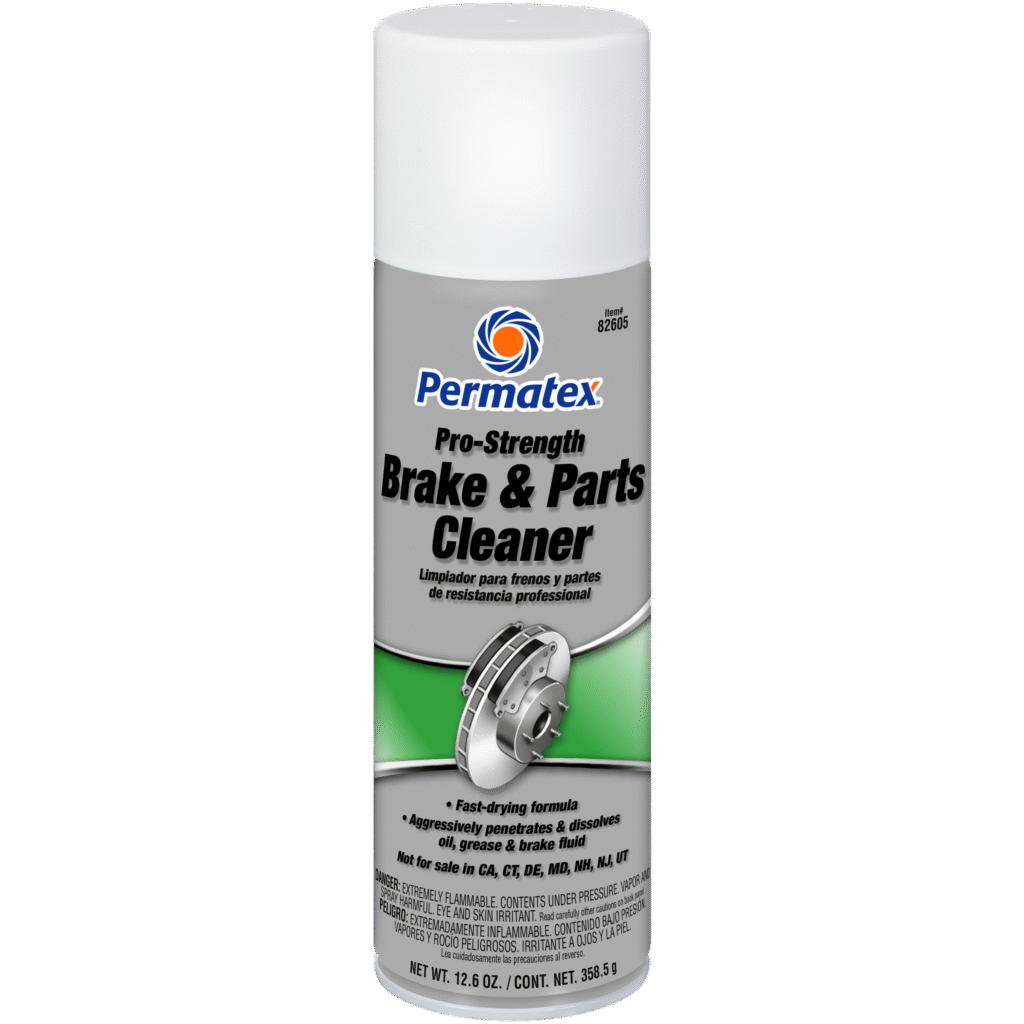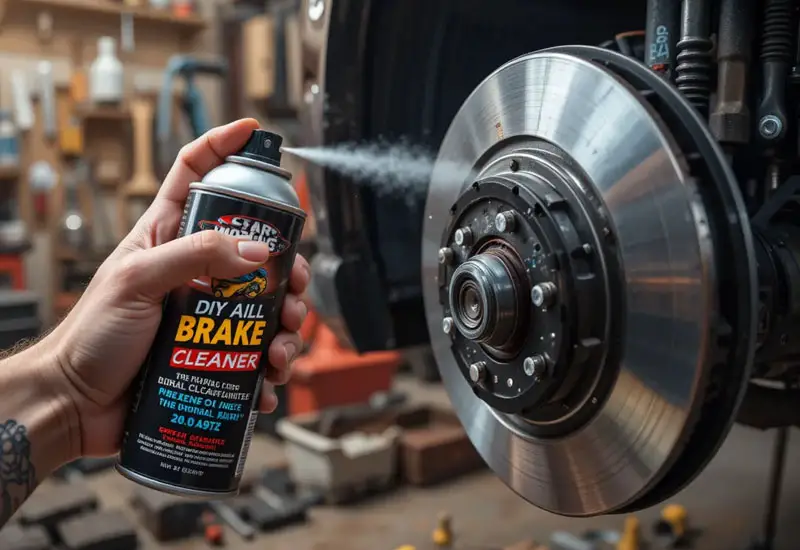Brake cleaner is typically made from a mixture of solvents, with the two main types being chlorinated and non-chlorinated. Chlorinated brake cleaners contain chemicals like perchloroethylene and methylene chloride, while non-chlorinated versions use solvents such as acetone, toluene, and heptane.
Brake cleaner is a powerful solvent used in the automotive industry to remove contaminants such as grease, oil, brake dust, and other debris from vehicle components, particularly the brake system. It’s designed to evaporate quickly and leave no residue, making it a popular choice for mechanics and DIY enthusiasts. But have you ever wondered what brake cleaner is actually made of?
In this article, we will explore the composition of brake cleaner, its types, and the safety and environmental concerns that come with its use.

Contents
What is Brake Cleaner and Why Is It Used?
Before we dive into the composition of brake cleaner, it’s important to understand what it is and why it’s used. Brake cleaner is a specialized solvent that is used to clean automotive brake components, such as rotors, calipers, pads, and drums, removing contaminants that may interfere with braking performance. In addition to brake components, brake cleaner is often used to clean other parts of the engine, including metal surfaces and other heavily contaminated areas.
The key features of brake cleaner are its ability to remove oils, grease, dirt, and other residues from metal surfaces quickly, without leaving any residue behind. This makes it an effective tool for ensuring clean, smooth operation in brake systems and other automotive parts.
The Chemical Composition of Brake Cleaner
Brake cleaner comes in two primary types: chlorinated and non-chlorinated. The difference between the two lies in the chemical composition and the specific solvents they contain. Each type of brake cleaner has its own set of benefits and drawbacks, which we’ll explore further below.
1. Chlorinated Brake Cleaner
Chlorinated brake cleaners are typically more powerful solvents compared to non-chlorinated varieties. These cleaners contain chlorine-based compounds that are effective at dissolving oils, greases, and other contaminants found on brake components. The major chemicals found in chlorinated brake cleaners include:
- Perchloroethylene (Tetrachloroethylene): This chemical is a powerful solvent and is commonly used in many chlorinated brake cleaners. It effectively removes grease, oil, and brake dust from metal surfaces. However, it has a strong odor, and prolonged exposure can be harmful to human health.
- Methylene Chloride (Dichloromethane): This solvent is known for its excellent degreasing properties and is commonly used in brake cleaners to remove oily contaminants. Like perchloroethylene, methylene chloride is toxic and requires careful handling.
- Trichloroethylene: Another solvent found in some chlorinated brake cleaners, trichloroethylene is effective at breaking down grease and oils. However, it is also harmful to both human health and the environment, which has led to restrictions in several regions.
Chlorinated brake cleaners are highly effective but come with environmental and health concerns. For this reason, many countries have started limiting their use, and some regions have banned the sale of chlorinated brake cleaners due to the harmful effects on the environment.
2. Non-Chlorinated Brake Cleaner
Non-chlorinated brake cleaners, as the name suggests, do not contain chlorine-based compounds. Instead, they use hydrocarbon-based solvents and are considered less hazardous to the environment. While they may not be as powerful as chlorinated cleaners, they are still highly effective at removing contaminants from metal surfaces. The ingredients typically found in non-chlorinated brake cleaners include:
- Acetone: Acetone is a highly volatile solvent that evaporates quickly, making it an effective solvent for brake cleaners. It can dissolve grease, oils, and other contaminants from metal surfaces. However, acetone is flammable and should be used with caution.
- Toluene: Toluene is another commonly used solvent in non-chlorinated brake cleaners. It is effective at dissolving oils and greases but is toxic and can cause dizziness, headaches, and other symptoms when inhaled in high concentrations.
- Heptane: Heptane is a hydrocarbon solvent that is used in brake cleaners for its excellent grease-dissolving properties. Like acetone, heptane is highly flammable and should be handled with care.
- Isopropyl Alcohol: Often found in non-chlorinated brake cleaners, isopropyl alcohol is a solvent that is safe for use on many surfaces and evaporates quickly without leaving residue behind.
- Methanol: Methanol is another solvent used in some non-chlorinated brake cleaners. It is highly effective at dissolving grease and oils but is toxic and can cause serious health issues if ingested or inhaled.
- Carbon Dioxide: Used as a propellant in aerosol brake cleaners, carbon dioxide helps spray the cleaner efficiently onto brake parts and other components. It’s considered a relatively safer option in comparison to the other propellants.
Non-chlorinated brake cleaners are typically considered safer for both the environment and human health, but they still contain chemicals that can be harmful if proper precautions aren’t followed.
How Brake Cleaner Works
The effectiveness of brake cleaner lies in its ability to dissolve grease, oil, brake dust, and other contaminants. When the cleaner is sprayed onto a contaminated surface, the solvent begins to break down and dissolve the oils and dirt. These contaminants then lift off the surface, allowing for easier removal by wiping or simply allowing the cleaner to evaporate.
The rapid evaporation of brake cleaner is one of the key features that makes it such a useful product. Unlike some other solvents, brake cleaner doesn’t leave behind any residue, ensuring that the cleaned parts are free from contaminants and ready to function optimally.
Health and Safety Considerations
Although brake cleaner is highly effective, it comes with certain risks. The chemicals used in both chlorinated and non-chlorinated brake cleaners can be harmful if inhaled, ingested, or if they come into contact with the skin. Here are some important health and safety considerations when using brake cleaner:
- Respiratory Risks: Inhaling brake cleaner vapors can cause dizziness, nausea, headaches, and respiratory problems. Always use brake cleaner in a well-ventilated area and wear protective gear such as a respirator mask.
- Skin and Eye Contact: Direct contact with brake cleaner can cause skin irritation, rashes, and even chemical burns. Protective gloves and safety goggles should be worn when using brake cleaner to avoid skin and eye contact.
- Flammability: Non-chlorinated brake cleaners, in particular, are highly flammable and should be kept away from open flames and heat sources. Ensure that the area is free from sparks, flames, or hot surfaces when using brake cleaner.
- Environmental Impact: Chlorinated brake cleaners, in particular, pose significant environmental risks due to the persistence of the chemicals in water and air. Many chlorinated solvents are not biodegradable and can contribute to pollution. Non-chlorinated options are generally considered safer for the environment, but caution should still be exercised in their disposal.

Frequently Asked Questions
Here are some FAQs about what is brake cleaner made of –
1. What is the difference between chlorinated and non-chlorinated brake cleaner?
Chlorinated brake cleaners contain chlorine-based solvents, which are more effective but have environmental and health concerns. Non-chlorinated brake cleaners use hydrocarbon-based solvents and are considered safer for the environment.
2. Can brake cleaner be used on all surfaces?
Brake cleaner is safe for most metal surfaces but can damage plastics, rubber seals, and painted surfaces. Always check the manufacturer’s guidelines for compatibility with the material.
3. How should I dispose of used brake cleaner?
Brake cleaner should be disposed of as hazardous waste according to local environmental regulations. Do not pour it down drains or throw it in the trash.
4. Can brake cleaner be used on electronic components?
Brake cleaner should be used cautiously on electronic components. It can damage sensitive parts like sensors or circuit boards. Always use products specifically designed for electronics when cleaning them.
5. How often should I clean my vehicle’s brakes with brake cleaner?
Brake cleaner should be used when cleaning brake components, but frequent cleaning isn’t necessary unless you’re working on brake maintenance or repairs. Regular brake inspections are recommended.
Conclusion
Knowing what brake cleaner is made of is essential for using it safely and effectively. Whether you choose a chlorinated or non-chlorinated product, it is important to be aware of the chemical composition, potential risks, and safety precautions. By selecting the right brake cleaner for your needs and using it responsibly, you can maintain clean and efficient automotive parts without compromising your health or the environment.